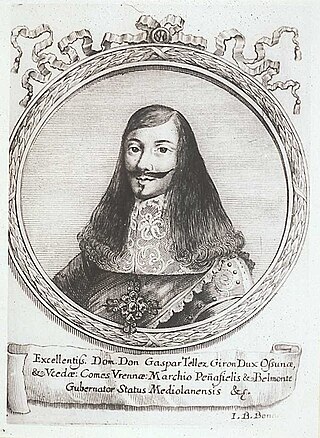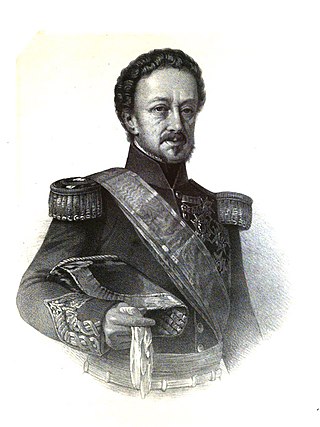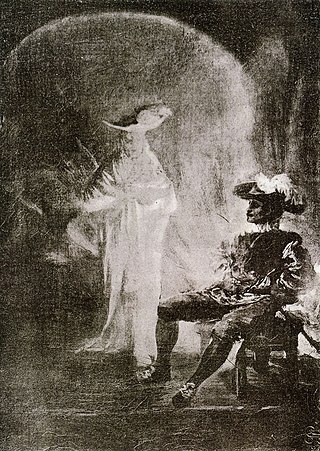
Duke of Osuna is a Spanish noble title that was first awarded in 1562 by King Philip II of Spain to Pedro Girón de la Cueva,. Pedro was also Viceroy of Naples, (1582–1586), Ambassador in Portugal and 5th Count of Ureña.

Pedro de Alcántara Téllez-Girón y Pacheco, 9th Duke of Osuna, Grandee of Spain, was a Spanish nobleman and military commander during the French Revolutionary Wars.

Lady María Josefa de Borja Pimentel y Téllez-Giróniure uxorisDuchess of Osuna, suo jure12th Duchess of Benavente, was a Spanish Salonnière, famous as a patron of artists, writers and scientists and an important figure of the Spanish Age of Enlightenment. She was the first female (honorary) member of the royal Sociedad Económica de Amigos del País de Madrid as well as the first president of the royal Junta de Damas de Honor y Mérito.

Doña Joaquina Téllez-Girón y Pimentel, 2nd Countess of Osilo, iure uxorisMarchioness of Santa Cruz was a daughter of Pedro Téllez-Girón, 9th Duke of Osuna and María Josefa Pimentel, 12th Countess-Duchess of Benavente.

Gaspar Téllez-Girón, 5th Duke de Osuna, 5th Marquess of Peñafiel, 9th Count of Ureña and other lesser titles, was a Spanish general and a Grandee of Spain.

Duke of Gandía is a title of Spanish nobility that was first created in 1399 by Martin of Aragon and granted to Alfonso of Aragon and Foix. It has its origin in the lordship of Gandía created in 1323 by James II of Aragon. Later, having no direct descendants, the title passed from the House of Barcelona to the House of Trastámara.

Francisco de Borja Téllez-Girón y Pimentel, 10th Duke de Osuna, Grandee of Spain, was a Spanish nobleman.

Duke of Plasencia is a hereditary title in the Spanish nobility. It was granted on 1476 by Queen Isabella I and King Ferdinand V of Castile, The Catholic Monarchs, to Álvaro de Zúñiga y Guzmán, 2nd count of Plasencia and also 1st Duke of Béjar, 1st Duke of Arévalo and 1st Count of Bañares, in acknowledgment for his loyalty during the War of Castilian Succession.

Pedro de Alcántara Téllez-Girón y Beaufort Spontin, 11th Duke of Osuna, GE, was a Spanish peer, head of the House of Osuna. He was one of the most important peers of his time, and was thirteen times a duke, twelve a marquess, thirteen a count and once a viscount.

Duke of Béjar is a hereditary title in the Peerage of Spain, accompanied by the dignity of Grandee and granted in 1485 by the Catholic Monarchs to Álvaro de Zúñiga, 1st Duke of Plasencia and chief justice of Castile.

Pedro de Alcántara Téllez Girón y Alfonso-Pimentel, 2nd Prince of Anglona (1786–1851) was a Spanish military officer during the Peninsular War and a politician.

Duke of Benavente is a hereditary title in the Peerage of Spain, accompanied by the dignity of Grandee and granted in 1473 by Henry IV to Rodrigo Alonso Pimentel, 4th Count of Benavente.
Marquess of Lombay is a noble title created by King Charles V of Spain in favor of Saint Francis Borgia Grandee of Spain, Duke of Gandia. on 7 July 1530.

José Gabriel de Silva-Bazán y Waldstein, 10th Marquess of Santa Cruz de Mudela, was a Spanish noble, first director of the Prado Museum between 1817 and 1820 and Mayordomo mayor between 1822 and 1823.
Ángela María Téllez-Girón y Duque de Estrada, 16th Duchess of Osuna, GE (1925–2015) was a Spanish noblewoman. She was a holder of ten grandeeships of Spain.
Guillermo Ducker was a Dutch miniaturist active mainly in Madrid, Spain between 1795 and 1830. He is known to have painted for Spain's royal family as well as for Madrid's high society, until at least 1813, when he painted a miniature of Joaquina Téllez Girón, Marchioness of Santa Cruz.

The series of paintings for the alameda of the Dukes of Osuna comprises seven pictures painted by Francisco de Goya between 1786 and 1787. The country estate of the dukes and duchesses, who were the painter's mecenas and friends, was known as El Capricho, and was located on the outskirts of Madrid.

The Witches' Kitchen is a painting by the Spanish artist Francisco Goya, located in a private collection in Mexico. It is part of a series of six cabinet paintings, each measuring approximately 43 × 30 cm, with the theme of witchcraft. The paintings do not together form a single narrative and do not share a common meaning, so it is appropriate to interpret each one individually. The entire series was owned by the Dukes of Osuna and adorned their summer residence, Alameda de Osuna. In addition to The Witches' Kitchen, the series includes: Witches' Sabbath, Witches' Flight, The Incantation, The Bewitched Man, and Don Juan and the Commendatore. Four of the paintings are in various public collections, one in a private collection, and the last is considered lost.

Don Juan and the Commendatore is a painting by the Spanish artist Francisco Goya. It belongs to a series of six cabinet paintings, each approximately 43 × 30 cm, with witchcraft as the central theme. The paintings do not form a single narrative and have no shared meaning, so each one is interpreted individually. The entire series was owned by the Dukes of Osuna and adorned their summer residence in Alameda de Osuna. In addition to Don Juan and the Commendatore, the series includes Witches' Sabbath, Witches' Flight, The Incantation, The Bewitched Man, and The Witches' Kitchen. Four of these paintings are housed in various public collections, one in a private collection, and Don Juan and the Commendatore is considered lost.

The Incantation is a painting by the Spanish artist Francisco Goya. It belongs to a series of six cabinet paintings, each approximately 43 × 30 cm, with witchcraft as the central theme. The paintings do not form a single narrative and have no shared meaning, so each one is interpreted individually. The entire series was owned by the Dukes of Osuna and adorned their summer residence in Alameda de Osuna. In addition to The Incantation, the series includes Witches' Sabbath, Witches' Flight, Don Juan and the Commendatore, The Bewitched Man, and The Witches' Kitchen. Four of the paintings are held in various public collections, one in a private collection, and the last is considered lost.
















